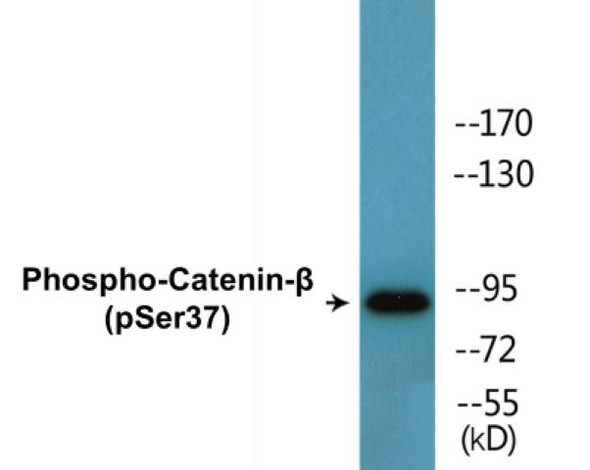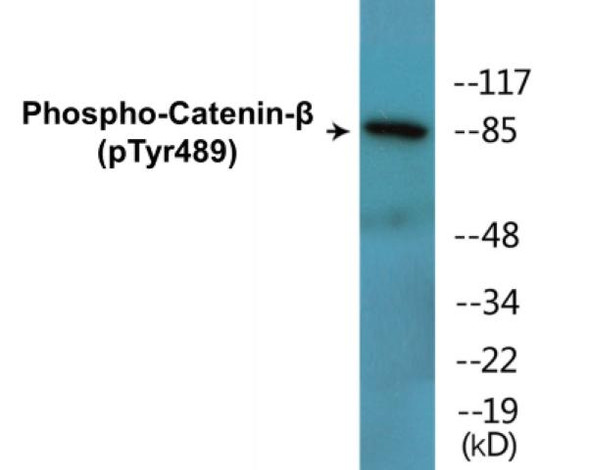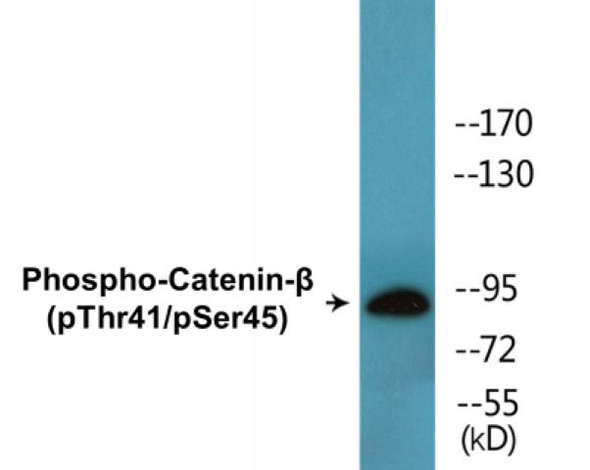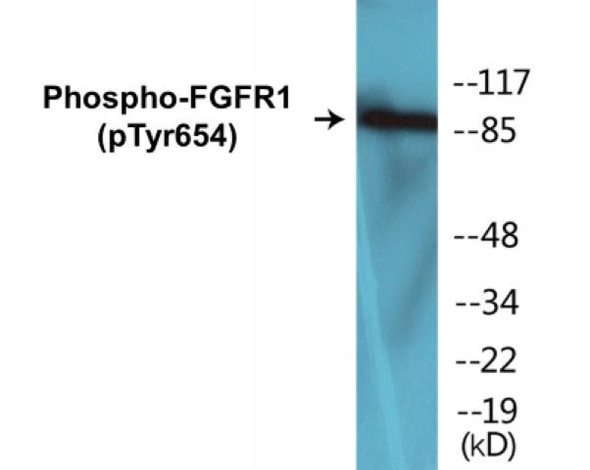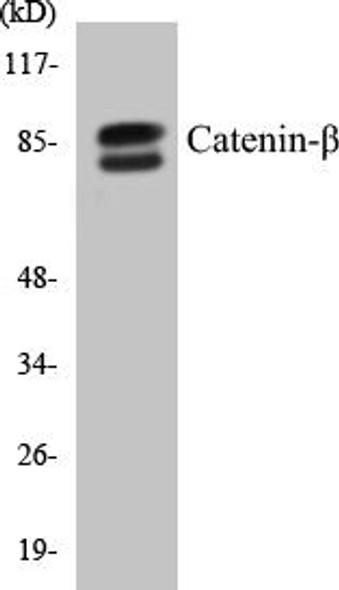Description
| Product Name: | Catenin-beta (Phospho-Tyr654) Colorimetric Cell-Based ELISA |
| Product Code: | CBCAB01399 |
| ELISA Type: | Cell-Based |
| Target: | Catenin-beta (Phospho-Tyr654) |
| Reactivity: | Human, Mouse, Rat |
| Dynamic Range: | > 5000 Cells |
| Detection Method: | Colorimetric 450 nm |
| Format: | 2 x 96-Well Microplates |
The Catenin-beta (Phospho-Tyr654) Colorimetric Cell-Based ELISA Kit is a convenient, lysate-free, high throughput and sensitive assay kit that can detect Catenin-beta protein phosphorylation and expression profile in cells. The kit can be used for measuring the relative amounts of phosphorylated Catenin-beta in cultured cells as well as screening for the effects that various treatments, inhibitors (ie. siRNA or chemicals), or activators have on Catenin-beta phosphorylation.
Qualitative determination of Catenin-beta (Phospho-Tyr654) concentration is achieved by an indirect ELISA format. In essence, Catenin-beta (Phospho-Tyr654) is captured by Catenin-beta (Phospho-Tyr654)-specific primary (1ø) antibodies while the HRP-conjugated secondary (2ø) antibodies bind the Fc region of the 1ø antibody. Through this binding, the HRP enzyme conjugated to the 2ø antibody can catalyze a colorimetric reaction upon substrate addition. Due to the qualitative nature of the Cell-Based ELISA, multiple normalization methods are needed:
| 1. | A monoclonal antibody specific for human GAPDH is included to serve as an internal positive control in normalizing the target absorbance values. |
| 2. | Following the colorimetric measurement of HRP activity via substrate addition, the Crystal Violet whole-cell staining method may be used to determine cell density. After staining, the results can be analysed by normalizing the absorbance values to cell amounts, by which the plating difference can be adjusted. |
| Database Information: | Gene ID: 1499, UniProt ID: P35222, OMIM: 116806/132600/155255, Unigene: Hs.476018 |
| Gene Symbol: | CTNNB1 |
| Sub Type: | Phospho |
| UniProt Protein Function: | CTNNB1: a regulator of cell adhesion and a key downstream effector in the Wnt signaling pathway. Implicated early embryonic development and tumorigenesis. Phosphorylated and destabilized by CK1 and GSK-3beta. Stabilized cytoplasmic beta-catenin is a hallmark of a variety of cancers. Stabilized beta-catenin translocates to the nucleus, where it acts as a transcriptional activator of T-cell factor (TCF)-regulated genes. Interacts with the PDZ domain of TAX1BP3, inhibiting its transcriptional activity. Two alternatively spliced human isoforms have been described. |
| UniProt Protein Details: | Protein type:Transcription factor; Motility/polarity/chemotaxis; Cell adhesion; Oncoprotein; Nuclear receptor co-regulator; Actin-binding Chromosomal Location of Human Ortholog: 3p21 Cellular Component: centrosome; basolateral plasma membrane; intercellular junction; fascia adherens; cytosol; beta-catenin destruction complex; transcription factor complex; cell-cell adherens junction; membrane; lamellipodium; perinuclear region of cytoplasm; cytoplasm; synapse; dendritic shaft; lateral plasma membrane; spindle pole; focal adhesion; tight junction; catenin complex; cell cortex; Z disc; nucleoplasm; adherens junction; microvillus membrane; apical part of cell; plasma membrane; nucleus; cell junction Molecular Function:protein C-terminus binding; transcription coactivator activity; transcription factor binding; protein phosphatase binding; ionotropic glutamate receptor binding; protein binding; signal transducer activity; enzyme binding; androgen receptor binding; cadherin binding; double-stranded DNA binding; protein complex binding; estrogen receptor binding; nitric-oxide synthase binding; SMAD binding; transcription factor activity; kinase binding; alpha-catenin binding; nuclear hormone receptor binding Biological Process: regulation of myelination; regulation of centriole-centriole cohesion; positive regulation of apoptosis; protein heterooligomerization; positive regulation of transcription, DNA-dependent; regulation of fibroblast proliferation; cell maturation; negative regulation of chondrocyte differentiation; T cell differentiation in the thymus; positive regulation of fibroblast growth factor receptor signaling pathway; osteoclast differentiation; Wnt receptor signaling pathway through beta-catenin; cell-cell adhesion; positive regulation of endothelial cell differentiation; regulation of cell fate specification; embryonic foregut morphogenesis; positive regulation of mesenchymal cell proliferation; male genitalia development; ectoderm development; synapse organization and biogenesis; cell adhesion; bone resorption; response to drug; positive regulation of neuroblast proliferation; positive regulation of I-kappaB kinase/NF-kappaB cascade; regulation of smooth muscle cell proliferation; transcription, DNA-dependent; hair cell differentiation; negative regulation of protein sumoylation; patterning of blood vessels; genitalia morphogenesis; muscle cell differentiation; midgut development; smooth muscle cell differentiation; positive regulation of transcription from RNA polymerase II promoter; embryonic digit morphogenesis; negative regulation of transcription, DNA-dependent; oocyte development; embryonic forelimb morphogenesis; negative regulation of osteoclast differentiation; glial cell fate determination; endodermal cell fate commitment; apoptosis; cell-matrix adhesion; neuron migration; dorsal/ventral axis specification; cell fate specification; positive regulation of histone H3-K4 methylation; negative regulation of transcription from RNA polymerase II promoter; embryonic hindlimb morphogenesis; response to estradiol stimulus; negative regulation of cell proliferation; central nervous system vasculogenesis; positive regulation of MAPKKK cascade; pancreas development; positive regulation of interferon type I production; fallopian tube development; proximal/distal pattern formation; layer formation in the cerebral cortex; negative regulation of mitotic cell cycle, embryonic; cell structure disassembly during apoptosis; Wnt receptor signaling pathway; hair follicle morphogenesis; thymus development; in utero embryonic development; regulation of T cell proliferation; neural plate development; stem cell maintenance; embryonic axis specification; synaptic vesicle transport; gastrulation with mouth forming second; liver development; regulation of angiogenesis; odontogenesis of dentine-containing teeth; myoblast differentiation; negative regulation of oligodendrocyte differentiation; Schwann cell proliferation; positive regulation of osteoblast differentiation; response to cadmium ion; ureteric bud branching; response to cytokine stimulus; androgen receptor signaling pathway; epithelial to mesenchymal transition; positive regulation of muscle cell differentiation; embryonic heart tube development; innate immune response; lens morphogenesis in camera-type eye; anterior/posterior axis specification Disease: Pilomatrixoma; Mental Retardation, Autosomal Dominant 19; Ovarian Cancer; Colorectal Cancer; Hepatocellular Carcinoma |
| NCBI Summary: | The protein encoded by this gene is part of a complex of proteins that constitute adherens junctions (AJs). AJs are necessary for the creation and maintenance of epithelial cell layers by regulating cell growth and adhesion between cells. The encoded protein also anchors the actin cytoskeleton and may be responsible for transmitting the contact inhibition signal that causes cells to stop dividing once the epithelial sheet is complete. Finally, this protein binds to the product of the APC gene, which is mutated in adenomatous polyposis of the colon. Mutations in this gene are a cause of colorectal cancer (CRC), pilomatrixoma (PTR), medulloblastoma (MDB), and ovarian cancer. Three transcript variants encoding the same protein have been found for this gene.[provided by RefSeq, Oct 2009] |
| UniProt Code: | P35222 |
| NCBI GenInfo Identifier: | 461854 |
| NCBI Gene ID: | 1499 |
| NCBI Accession: | P35222.1 |
| UniProt Secondary Accession: | P35222,Q8NEW9, Q8NI94, Q9H391, A8K1L7, |
| UniProt Related Accession: | P35222 |
| Molecular Weight: | |
| NCBI Full Name: | Catenin beta-1 |
| NCBI Synonym Full Names: | catenin (cadherin-associated protein), beta 1, 88kDa |
| NCBI Official Symbol: | CTNNB1 |
| NCBI Official Synonym Symbols: | CTNNB; MRD19; armadillo |
| NCBI Protein Information: | catenin beta-1 |
| UniProt Protein Name: | Catenin beta-1 |
| UniProt Synonym Protein Names: | Beta-catenin |
| Protein Family: | Catenin |
| UniProt Gene Name: | CTNNB1 |
| UniProt Entry Name: | CTNB1_HUMAN |
| Component | Quantity |
| 96-Well Cell Culture Clear-Bottom Microplate | 2 plates |
| 10X TBS | 24 mL |
| Quenching Buffer | 24 mL |
| Blocking Buffer | 50 mL |
| 15X Wash Buffer | 50 mL |
| Primary Antibody Diluent | 12 mL |
| 100x Anti-Phospho Target Antibody | 60 µL |
| 100x Anti-Target Antibody | 60 µL |
| Anti-GAPDH Antibody | 60 µL |
| HRP-Conjugated Anti-Rabbit IgG Antibody | 12 mL |
| HRP-Conjugated Anti-Mouse IgG Antibody | 12 mL |
| SDS Solution | 12 mL |
| Stop Solution | 24 mL |
| Ready-to-Use Substrate | 12 mL |
| Crystal Violet Solution | 12 mL |
| Adhesive Plate Seals | 2 seals |
The following materials and/or equipment are NOT provided in this kit but are necessary to successfully conduct the experiment:
- Microplate reader able to measure absorbance at 450 nm and/or 595 nm for Crystal Violet Cell Staining (Optional)
- Micropipettes with capability of measuring volumes ranging from 1 µL to 1 ml
- 37% formaldehyde (Sigma Cat# F-8775) or formaldehyde from other sources
- Squirt bottle, manifold dispenser, multichannel pipette reservoir or automated microplate washer
- Graph paper or computer software capable of generating or displaying logarithmic functions
- Absorbent papers or vacuum aspirator
- Test tubes or microfuge tubes capable of storing ≥1 ml
- Poly-L-Lysine (Sigma Cat# P4832 for suspension cells)
- Orbital shaker (optional)
- Deionized or sterile water
*Note: Protocols are specific to each batch/lot. For the correct instructions please follow the protocol included in your kit.
| Step | Procedure |
| 1. | Seed 200 µL of 20,000 adherent cells in culture medium in each well of a 96-well plate. The plates included in the kit are sterile and treated for cell culture. For suspension cells and loosely attached cells, coat the plates with 100 µL of 10 µg/ml Poly-L-Lysine (not included) to each well of a 96-well plate for 30 minutes at 37 °C prior to adding cells. |
| 2. | Incubate the cells for overnight at 37 °C, 5% CO2. |
| 3. | Treat the cells as desired. |
| 4. | Remove the cell culture medium and rinse with 200 µL of 1x TBS, twice. |
| 5. | Fix the cells by incubating with 100 µL of Fixing Solution for 20 minutes at room temperature. The 4% formaldehyde is used for adherent cells and 8% formaldehyde is used for suspension cells and loosely attached cells. |
| 6. | Remove the Fixing Solution and wash the plate 3 times with 200 µL 1x Wash Buffer for five minutes each time with gentle shaking on the orbital shaker. The plate can be stored at 4 °C for a week. |
| 7. | Add 100 µL of Quenching Buffer and incubate for 20 minutes at room temperature. |
| 8. | Wash the plate 3 times with 1x Wash Buffer for 5 minutes each time. |
| 9. | Add 200 µL of Blocking Buffer and incubate for 1 hour at room temperature. |
| 10. | Wash 3 times with 200 µL of 1x Wash Buffer for 5 minutes each time. |
| 11. | Add 50 µL of 1x primary antibodies Anti-Catenin-beta (Phospho-Tyr654) Antibody, Anti-Catenin-beta Antibody and/or Anti-GAPDH Antibody) to the corresponding wells, cover with Parafilm and incubate for 16 hours (overnight) at 4 °C. If the target expression is known to be high, incubate for 2 hours at room temperature. |
| 12. | Wash 3 times with 200 µL of 1x Wash Buffer for 5 minutes each time. |
| 13. | Add 50 µL of 1x secondary antibodies (HRP-Conjugated AntiRabbit IgG Antibody or HRP-Conjugated Anti-Mouse IgG Antibody) to corresponding wells and incubate for 1.5 hours at room temperature. |
| 14. | Wash 3 times with 200 µL of 1x Wash Buffer for 5 minutes each time. |
| 15. | Add 50 µL of Ready-to-Use Substrate to each well and incubate for 30 minutes at room temperature in the dark. |
| 16. | Add 50 µL of Stop Solution to each well and read OD at 450 nm immediately using the microplate reader. |
(Additional Crystal Violet staining may be performed if desired – details of this may be found in the kit technical manual.)


